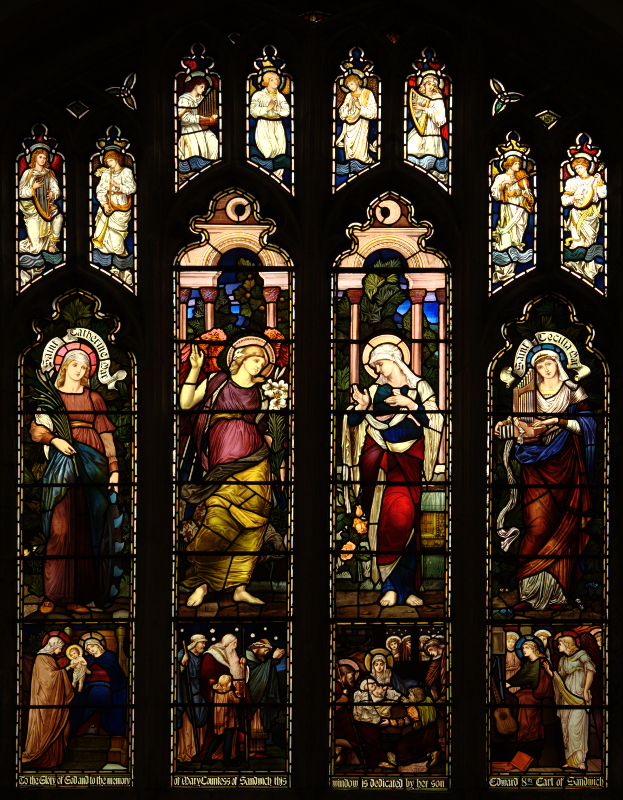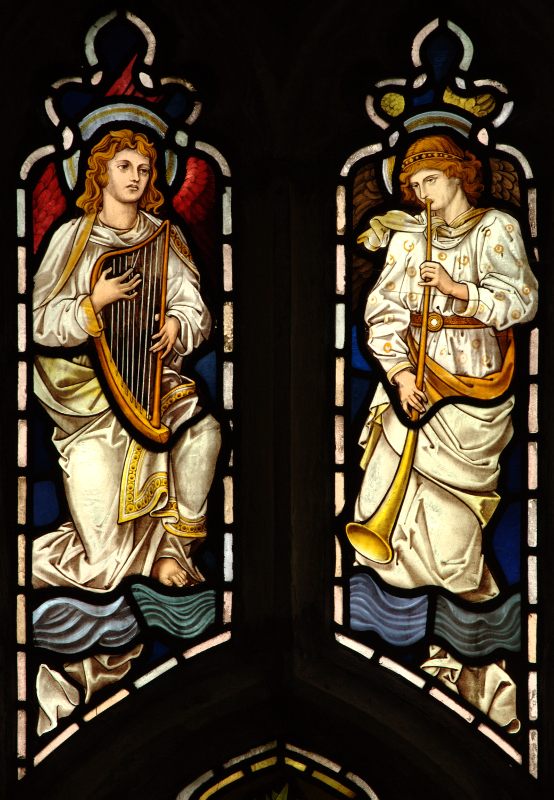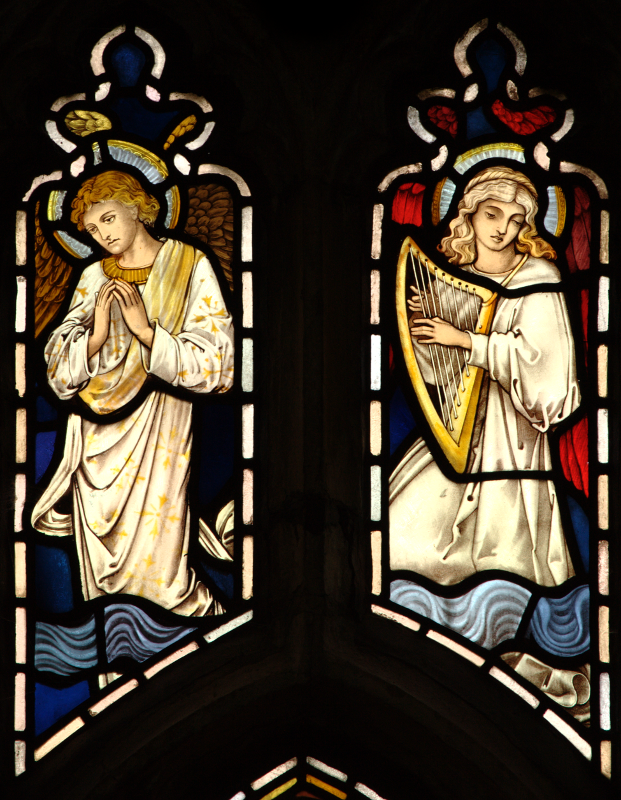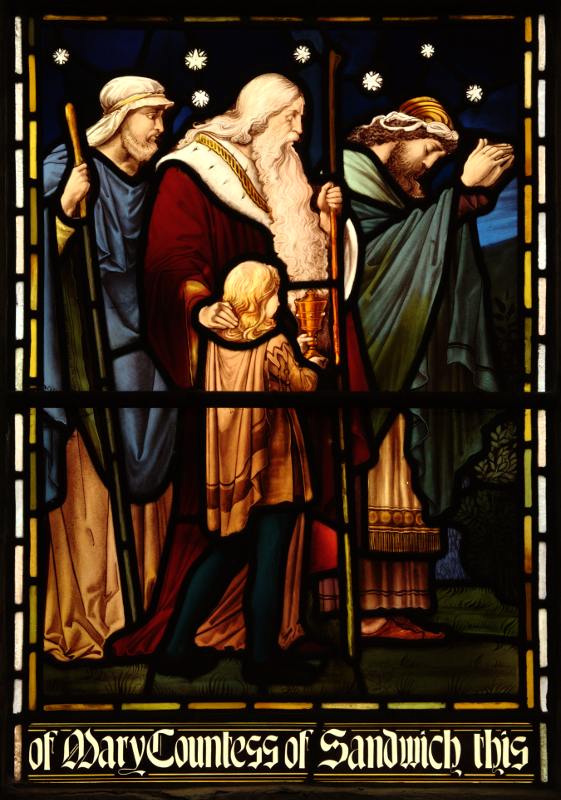Fouracre outside the Southwest
Introduction
The great majority of the output of the Fouracre stained-glass studio, of Stonehouse, Plymouth, Devon, went into buildings in Devon9 and Cornwall8. It is therefore interesting to examine those few of their windows that are outside these counties.
St Bartholomew, Whittingham, Northumberland, ().

Cast thy bread upon the waters: for thou shalt find it after many days ().
TO THE GLORY OF GOD & IN MEMORY OF R.W.GOODENOUGH VICAR OF THIS PARISH 1836 to 1880. BY HIS PARISHIONERS AND FRIENDS.
Figure 010. Whittingham, St Bartholomew, .
This window was inserted in in memory of the Revd Robert William Goodenough, who was vicar of Whittingham from to . The Revd Goodenough is noted for having attempted to demolish part of the old tower of his church using gunpowder!100

Figure 020. Whittingham, St Bartholomew, . The main panel of the central light, showing Christ in Majesty.

Figure 020.
Whittingham, St Bartholomew, . The emblem at the bottom of the central light,
showing the pelican in her piety
, feeding her young.

Figure 030. Whittingham, St Bartholomew, . Fruit and foliage of the vine at the top of the central light.
The window has five lights, showing Christ as the Good Shepherd in the centre and the four Evangelists in the outer lights. Below Christ is a pelican in her piety, and below each of the Evangelists is their traditional symbol. The tracery contains, at the top, the Dove of the Holy Spirit in a sunburst. Foliage is used extensively, both in the tracery and in ‘canopies’ over the five main panels, probably reflecting the influence of artists such as William Morris and Edward Burne-Jones. The Evangelists’ emblems along the bottom are reminiscent of the designs by Philip Webb, another member of William Morris’ circle.

Figure 040. Whittingham, St Bartholomew, . First light, main panel. St Matthew, holding a quill pen and scroll.

Figure 050. Whittingham, St Bartholomew, . First light: lower. An angel, the emblem of St Matthew.
How did Fouracre & Watson, a firm based in Plymouth, Devon, most of whose work went into Westcountry buildings,
come to make a window for a church in Northumberland? No documentary evidence has been found to answer this, but
there is a plausible explanation. Among those who attended the funeral of the Revd Goodenough
in were the second Earl of Ravensworth and
the Hon. A. Liddell
.101
A few years later, a committee was appointed to organise a memorial to the Revd Goodenough, and the
chairman of this committee was the Hon. Mr. Liddell
.102
It seems likely that the honorable gentleman was Atholl Charles John Liddell, the younger brother of the second Earl, who was
to become the third Earl in for a short time until his death the following year.
In Atholl Liddell married
Caroline Cecilia Edgcumbe,103 the daughter
of Hon George Edgcumbe, who was the uncle of the fourth Earl of Mount Edgcumbe.
John Fouracre, himself a freemason, had close connections with the Earl of Mount Edgcumbe,
a prominent Cornish freemason, and Fouracre obtained much work in Cornwall through
these connections.8
A report104
of Atholl Liddell’s death in
states that Lord Ravensworth [Atholl Liddell, by now the third Earl]
had lived for many years in Devonshire, at the Winter Villa,
Stonehouse105,
a pretty place belonging to his relative, Lord Mount
Edgcumbe.
Stonehouse, now a district of Plymouth but at the time
a separate town, was also the location of the Fouracre studio. So Atholl Liddell
had very close links with the Edgcumbe family
and lived near the Fouracre studio. It is therefore hardly surprising that
Fouracre was chosen to make the Goodenough memorial window, even though it
was to be inserted in a church at the opposite end of the country.
There is in Whittingham a small statue of Atholl, third Earl of Ravensworth, erected by his widow, Caroline, Countess Ravensworth, as a memorial to him.
St Mary Magdalene, Brampton, Huntingdonshire (now Cambridgeshire), ().

To the Glory of God and to the memory of Mary Countess of Sandwich this window is dedicated by her son Edward 8th Earl of Sandwich
Figure 1. s6. The Annunciation window.
This window, known as the Annunciation window, was inserted in .4,5 It is in memory of Mary Montagu, née Paget, Countess of Sandwich, who died on .2 She predeceased her husband, the seventh Earl of Sandwich, who died on 3 when their eldest son Edward Montagu, the donor of the window, inherited the title and became the eighth Earl.
The window was designed by John William Brown1,6
and made by the Plymouth firm of Fouracre and Watson who were specially selected for the work by
the Earl of Sandwich, who has expressed himself highly pleased with the design and
execution of the window.
5
The majority of Fouracres’ work is to be found in Devon and Cornwall, and this is the only known
window of theirs in East Anglia. It is not known why the Earl of Sandwich chose Fouracre, but it may
have been related to his Masonic connections,7
and possibly an acquaintance with the Earl of Mount Edgcumbe, himself a prominent westcountry Freemason.
These two connections, freemasonry and the Earl of Mount Edgcumbe,
undoubtedly helped Fouracre to obtain many commissions in Cornwall.8
The principal subject of the window, the Annunciation to the Blessed Virgin Mary, is probably a reflection of the dedicatee’s first name. St Catherine of Alexandria, shown on the left, is often depicted as attending on the Virgin and Child, and this may be a reference to the appointment by Queen Victoria of the Countess as a Lady of the Bedchamber, or personal attendant. St Cecilia, the patron saint of musicians, shown on the right, may refer to the Countess’ enjoyment or performance of music. Six of the eight angels in the tracery are shown playing musical instruments, further contributing to the musical theme of the window.
The designs for five of the angels in the tracery (the angels in the left-hand light, playing a harp and a trumpet, one of the angels in the third light, playing another harp, and the angels in the right-hand light, playing a viol and a lute) were re-used in in the iron Mission Church of St Agatha in the hamlet of Draynes in Cornwall (subsequently moved to the south aisle of the nearby church of St Cleer), but the quality of the work at Draynes is noticeably inferior. This probably reflects the limited funds available to glaze a prefabricated structure in a Cornish hamlet, compared with this prestigious commission at Brampton.

Figure 2. Tracery above the left-hand light, showing angels playing musical instruments. The left-hand angel is playing a harp and the right-hand angel is playing a trumpet.

Figure 3. Tracery above the second light, showing two angels. The left-hand angel is playing an organ (with the shortest pipes at the left-hand end!) and the right-hand angel is clasping its hands in prayer.

Figure 4. Tracery above the third light, showing two angels. The left-hand angel is clasping its hands in prayer and the right-hand angel is playing a harp.

Figure 5. Tracery above the right-hand light, showing two angels. The left-hand angel is playing a viol or violin and the right-hand angel is playing a plucked, four-stringed instrument.

Saint Catherine Mar[tyr]
Figure 6. s6 2a. The left-hand main panel shows St Catherine of Alexandria. Her left hand rests on a wheel, the instrument of her martrydom, and in her right hand she holds a martyr’s palm frond.

Figure 9. s6 1a. The left-hand predella shows the Mystical Marriage of St Catherine of Alexandria, a legend that first appeared in the medieval Golden Legend. On the right is the Blessed Virgin Mary, in her usual colour of blue, holding the Infant Jesus who is putting a ring on St Catherine’s finger, by which St Catherine consecrates herself and her virginity to Him. The scene shown in a predella usually illustrates an aspect of the subject of the main light above it, so this interpretation seems more likely than the one previously suggested.1


Figure 7. s6 2b and s6 2c. The second and third main panels show the Annunciation to the Blessed Virgin Mary. The angel Gabriel, on the left, tells Mary that she will conceive and bear the child Jesus (). Gabriel holds a lily, the symbol of virginity, and at Mary’s feet are roses, also symbols of purity and perfection.

Figure 10. s6 1b. The second predella, showing the three Magi accompanied by a page boy. The central figure, with white hair and flowing beard, is Caspar. The figure on the left has a grey beard, so may be the middle-aged Melchior, in which case Balthazar, a young man, is on the right. The journey of the Magi to worship the infant Jesus is, like the Nativity in the next predella, an event that followed on from the Annunciation shown in the main lights above it.

Figure 11. s6 1c. The third predella, showing the Nativity. The Blessed Virgin Mary holds the infant Jesus. On the left is Joseph, holding a staff. In the background on the right are angels playing harps. A man, perhaps a shepherd, kneels at Mary’s feet while at the left in the background is a horned ox and, on the far right, a sheep. The Nativity is, like the journey of the Magi in the previous predella, an event that followed on from the Annunciation shown in the main lights above it.

Saint Cecilia Mar[tyr]
Figure 8. s6 2d. The right-hand main panel shows St Cecilia, the patron saint of musicians, carrying an organ, supported on a knotted strip of fabric. Her left hand is on the keyboard and her right hand is working the bellows to provide the air for the instrument (which has the shorter, higher-pitched pipes at the left-hand end of the keyboard, presumably to help the pictorial composition of the scene).

Figure 12.
s6 1d. The right-hand predella
shows St Cecilia seated at a keyboard, probably of an organ,
singing while angels listen. This is a common representation
of her, because at her wedding she sang in her heart to God.
The scene illustrates the line She drew an angel down
from Alexander’s Feast, or the Power of Music,
an ode by John Dryden.
The guitar hanging up unused illustrates her rejection of the earthly
instruments of Bacchus in favour of heavenly music.
Once again, this interpretation of the scene in the predella illustrates
an aspect of the subject of the main light above it, and therefore seems
more likely than the one previously suggested.1
All Saints, Dewsbury, Yorkshire (now Dewsbury Minster, West Yorkshire), ().

To the Glory of God and in memory of the Revd Thos Allbutt MA Twenty-eight years Vicar of this Parish.
Dewsbury, All Saints, Chancel south.
Between and the parish church of All Saints, Dewsbury, was considerably enlarged. The designs had been drawn up by the architect , but he died in and the work was supervised by his son, , together with Albert Kirk of Dewsbury. This enlargement included a new chancel, one of whose windows was made by Fouracre and Watson200. The window was in memory of the Revd Thomas Allbutt, who had been vicar of Dewsbury from to , and was paid for by public subscription. It was one of several new windows inserted in time for the consecration by the Bishop of Ripon of the new chancel on .201



Dewsbury, All Saints, Chancel south. Montage of the upper main lights. The centre light shows Christ as the Good Shepherd with angels holding scrolls in the left- and right-hand lights.
The window is of three lights, divided by a transom to create two scenes. The upper scene shows Christ as the Good Shepherd in the centre light, with angels on either side; the designs for the two angels had been used the previous year in Wembury, in Devon, with the centre light depicting St Werburgh202, the patronal saint of the church,, and were used again in in St Mabyn in Cornwall, with the centre light depicting King David playing a harp.



Suffer little children, and forbid them not, to come unto me ().
Dewsbury, All Saints, Chancel south. Montage of the lower main lights.
The lower scene illustrates “Suffer little children” across the three lights. This seems to have been one of Fouracre’s most popular designs; the left-hand and centre lights were used in in in Lydford, where the lights were slightly wider, in in Kingsbridge, , where all three lights were of a very similar design to Dewsbury, in in Lanivet, , another three-light scene very similar to Dewsbury, and in in St Dominick, , where the left and centre lights are similar to the wider Lydford version, and the some of the figures in the right-hand light have been changed compared with the other three-light versions. Comparison of the lower lights (“Suffer little children”) with Lanivet (comparisons of left-, centre and right- hand panels) illustrates well the difference between the painting styles of Henry Watson, in the 1880s, and David Snell, from the 1890s onwards, applied to the same design.
How Fouracre obtained this commission is not known; the window was funded by public subscription and there does not seem to be any connection between the management of the restoration and extension work in the church (during which the window was inserted) and a patron such as the Earl of Mount Edgcumbe, the Earl of Sandwich or the Earl of Ravensworth. There is, however, a connection between Dewsbury and the West Country at about this time; James Henry Dyson of Dewsbury was the contractor responsible for the decorations in Truro in connection with the visit of the Prince and Princess of Wales (the future King Edward and Queen Alexandra) in for the consecration of Truro Cathedral.203 This may, however, be complete coincidence!
St Andrew, Cullompton, Devon, ().

To the Glory of God and in loving memory of George Forrester, B.A., born at Douglas, Isle of Man, died at Hollington, Sussex, . Vicar of S. Paul’s, Clapham to , Vicar of Cullompton Devon, to .
Cullompton, St Andrew, Lady Chapel south.
High-resolution image will start to load shortly …
The history of this window is closely interconnected with that of St Mary, Islington, , so it is included here, even though Cullompton is in the Westcountry, within Fouracre’s “home territory.” It is in memory of the Revd George Forrester, who was vicar of Cullompton from to . The window consists of four lights and shows two scenes from the life of Barnabas. In the left-hand scene, Barnabas gives the apostles the money from the sale of his land (). In the right-hand scene, Barnabas introduces Saul to the apostles (). In each scene Barnabas’ head appears to be a photographic likeness, presumably of the Revd Forrester. The window was unveiled in by the vicar of Islington, the Revd Charles James Procter, who was the brother-in-law of the dedicatee (their wives were sisters), and who was to become, in his turn, the dedicatee of a Fouracre window (see below) in St Mary, Islington, donated by his widow.
In the design of the left-hand scene was re-used, in a slightly compressed form, for the right-hand predella of St Austell, Holy Trinity, , in Cornwall.
St Mary, Islington, London, ().
This window, inserted in , is in memory of
the Revd Charles James Procter, who was vicar of Islington from
to ,
and was also a Prebendary of St Paul’s Cathedral. It was donated by his widow,
Mrs Emily Eliza Procter, whose late brother-in-law, the Revd George Forrester, had been
vicar of Cullompton in Devon. Revd Procter had in
unveiled a window by Fouracre in Cullompton (see above) in memory of the Revd Forrester (their wives were sisters), and
so pleased was Mrs. Procter with a memorial window to her sister [actually to her sister’s husband],
erected at Cullompton by Mr. W.D. Snell … that she commissioned
him to execute the present work … .
300
The window was unveiled on by
Bishop John Taylor Smith,301
who had recently retired as Chaplain-General to the Forces.
Unfortunately the window was destroyed early in the London Blitz, on ,302 by a bomb that landed directly on the church. The only known photograph of it is one that appeared in a Westcountry newspaper at the time of its insertion.

In loving memory of Charles James Procter, M.A., Prebendary of Islington in St. Paul’s Cathedral, vicar of this parish from –.
From the . Image © Trinity Mirror. Image created courtesy of THE BRITISH LIBRARY BOARD.
Image © Trinity Mirror. Image created courtesy of THE BRITISH LIBRARY BOARD.
The article proclaimed that
Fouracre and Son are continually sending specimens of
their work to all parts of the United Kingdom, and to places as far apart
as the Argentine and Straits Settlements, India and New Zealand.
301
There is, however, very little evidence, at least in Cornwall, of this outpouring of work, where only
new windows are
known from until ,
when the firm was amalgated with Osborne & Son.
References
- R Noble, St Mary Magdalene Church, Brampton, The Stained Glass Windows. Second Edition, 2014.
- .
- .
- .
- , and a similar article two weeks later in The Hunts County Guardian p 6.
- .
- Obituary of eighth Earl of Sandwich (donor of window) in The Huntingdonshire Post p 3. Funeral in The Huntingdonshire Post p 3. Representatives of the Loyal Lord Hinchingbrooke Lodge (M.U.) present.
- Swift MG, Stained glass windows in Cornwall by the Plymouth firm of Fouracre.
- .
- Winstanley, Bridget. Whittingham’s parish church and associated structures: the legacy of the Rev. R.W. Goodenough, Records & Recollections, Vol 3, No 3, Summer 2015, p 9, Aln & Breamish Local History Society.
- .
- , .
- .
- .
- Photograph of Winter Villa, Stonehouse.
- .
- , .
- .
- .
- .
- .
- S Allen Chambers, Jr., History of St Mary Islington p 87.